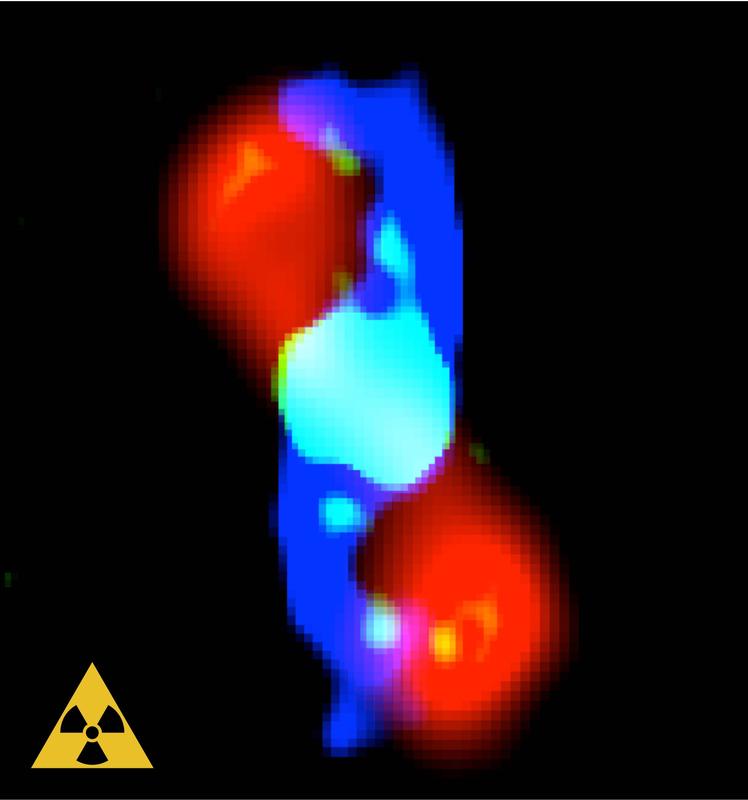26AlF – the first detection of a radioactive molecule in space

Components of the nebula around the star CK Vul: diazenylium (N2H+) in blue, methanol (CH3OH) in red and AlF in cyan/green/yellow. The radioactive 26AlF was observed only in the very inner region. T. Kamiński
The variable star CK Vulpeculae (CK Vul) is known as the location of a stellar outbreak, a nova, which was observed by European astronomers in the 17th century in the direction of the constellation “Vulpecula” (the little fox). Nova Vul 1670 was easily visible with the naked eye and varied in brightness significantly over the course of two years.
It took a long time, until 2013, before astronomers, first using the Atacama Pathfinder Experiment telescope (APEX), could trace molecular gas of a very peculiar isotopic composition in the stellar remnant. Analysis of these very surprising findings indicated that a rare and spectacular stellar merger of two stars took place. The collision created a so-called red transient source or a red nova, a newly recognized class of eruptive stars.
The observation of the 26Al isotope provides direct insight into the merger process in CK Vul showing that even the deep and dense inner layers of the star can eventually be exposed in a stellar collision. More specifically, the observations constrain the nature of the binary system that merged more than 300 years ago: a low-mass binary that contained a red-giant-branch star of a mass of 0.8-2.5 solar masses.
This first direct observation of 26Al in a stellar-like object is also important in the broader context of the Galactic chemical evolution – this is the first time an active producer of the radioactive nuclide 26Al has been directly observationally identified. It has been known for decades that about two solar masses of 26Al is spread across the Galaxy.
Although observable in gamma-ray emission, this radioactive cloud has unclear origin. With current estimates on the mass of 26Al in CK Vul and the Galactic merger rate, it seems rather unlikely that mergers are solely responsible for this Galactic radioactive material. However, the actual mass of 26Al in atomic form in CK Vul and other merger remnants may be much higher and the current merger rates can be very much underestimated, so this is not a closed issue and the role of mergers may be non-negligible.
In addition to putting into spotlight a new type of objects not considered before in the context of Galactic 26Al production, the discovery illustrates that modern millimeter-wave interferometers such as ALMA may be used to search for active 26Al producers at much better angular resolutions than gamma-ray observatories.
Another interesting aspect of the work is that the line positions were first calculated by molecular spectroscopists, who are co-authors of the study. Characterizing material containing 26Al in through direct measurements in a laboratory would be very challenging and expensive so calculations were the only practical option. The observed transitions match perfectly the predicted ones.
CK Vul remains an enigmatic source in the sky providing a playground for new astronomical detections.
The discovery involved the following telescopes/facilities: APEX, IRAM 30m, NOEMA, ALMA, and SMA. The most relevant observations were done with the transforming PdbI/NOEMA interferometer and with the ALMA array, including its newly commissioned band 5 receiver.
The research team comprises Tomasz Kamiński, Romuald Tylenda, Karl M. Menten, Amanda Karakas, Jan Martin Winters, Alexander A. Breier, Ka Tat Wong, Thomas F. Giesen, and Nimesh A. Patel.
Karl M. Menten, director at MPIfR and head of its Millimeter and Submillimeter Astronomy division, is co-author of the paper.
Prof. Dr. Karl M. Menten
Director and Head of Research Department “Millimeter and Submillimeter Astronomy”
Max-Planck-Institut für Radioastronomie, Bonn.
Fon: +49 228 525-297
E-mail: kmenten@mpifr-bonn.mpg.de
Dr. Tomasz Kaminski
Harvard-Smithsonian Centre for Astrophysics (CfA)
Fon: +1 617-495-7259
E-mail: tomasz.kaminski@cfa.harvard.edu
Tomasz Kamiński et al.: Astronomical detection of a radioactive molecule 26AlF in a remnant of an ancient explosion, Advanced Online Publication (AOP), Nature Astronomy, July 30, 2018 (dx.doi.org/10.1038/s41550-018-0541-x).
Media Contact
All latest news from the category: Physics and Astronomy
This area deals with the fundamental laws and building blocks of nature and how they interact, the properties and the behavior of matter, and research into space and time and their structures.
innovations-report provides in-depth reports and articles on subjects such as astrophysics, laser technologies, nuclear, quantum, particle and solid-state physics, nanotechnologies, planetary research and findings (Mars, Venus) and developments related to the Hubble Telescope.
Newest articles

A ‘language’ for ML models to predict nanopore properties
A large number of 2D materials like graphene can have nanopores – small holes formed by missing atoms through which foreign substances can pass. The properties of these nanopores dictate many…

Clinically validated, wearable ultrasound patch
… for continuous blood pressure monitoring. A team of researchers at the University of California San Diego has developed a new and improved wearable ultrasound patch for continuous and noninvasive…

A new puzzle piece for string theory research
Dr. Ksenia Fedosova from the Cluster of Excellence Mathematics Münster, along with an international research team, has proven a conjecture in string theory that physicists had proposed regarding certain equations….



